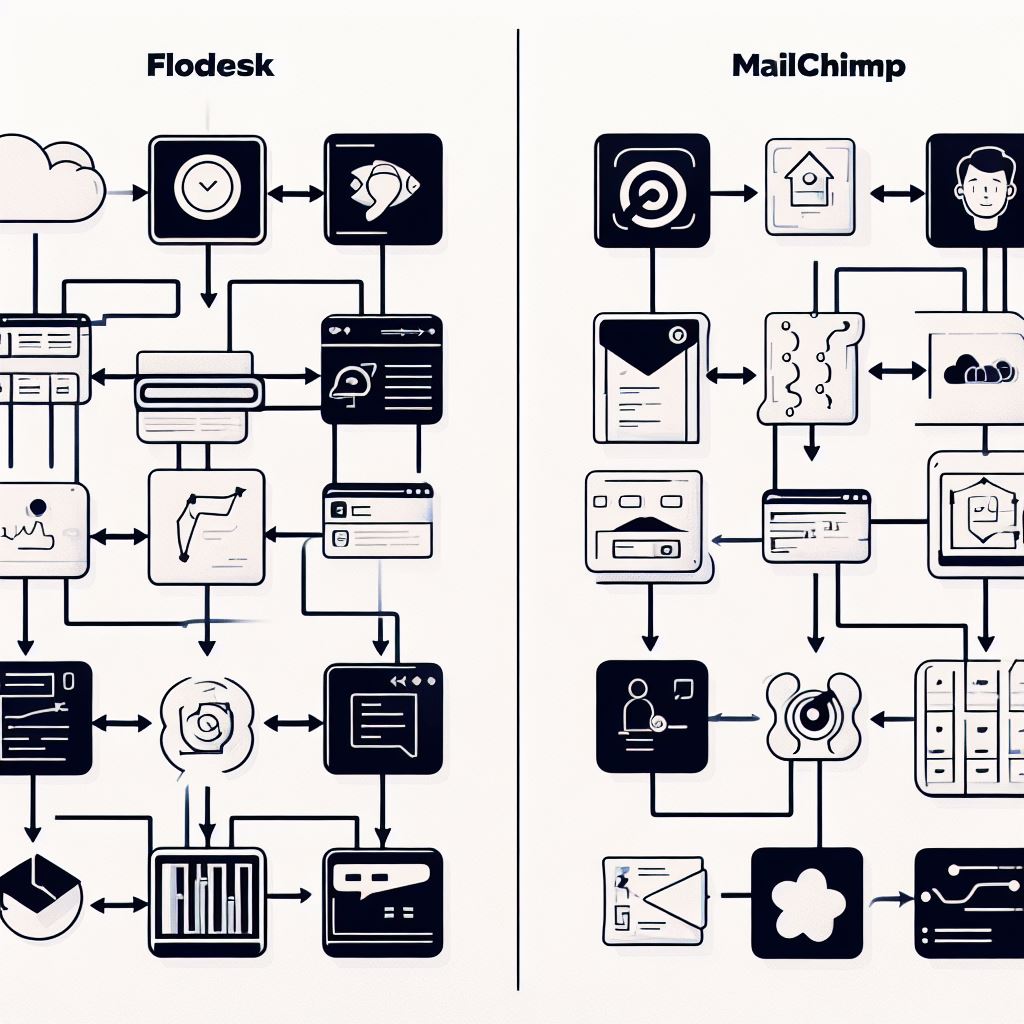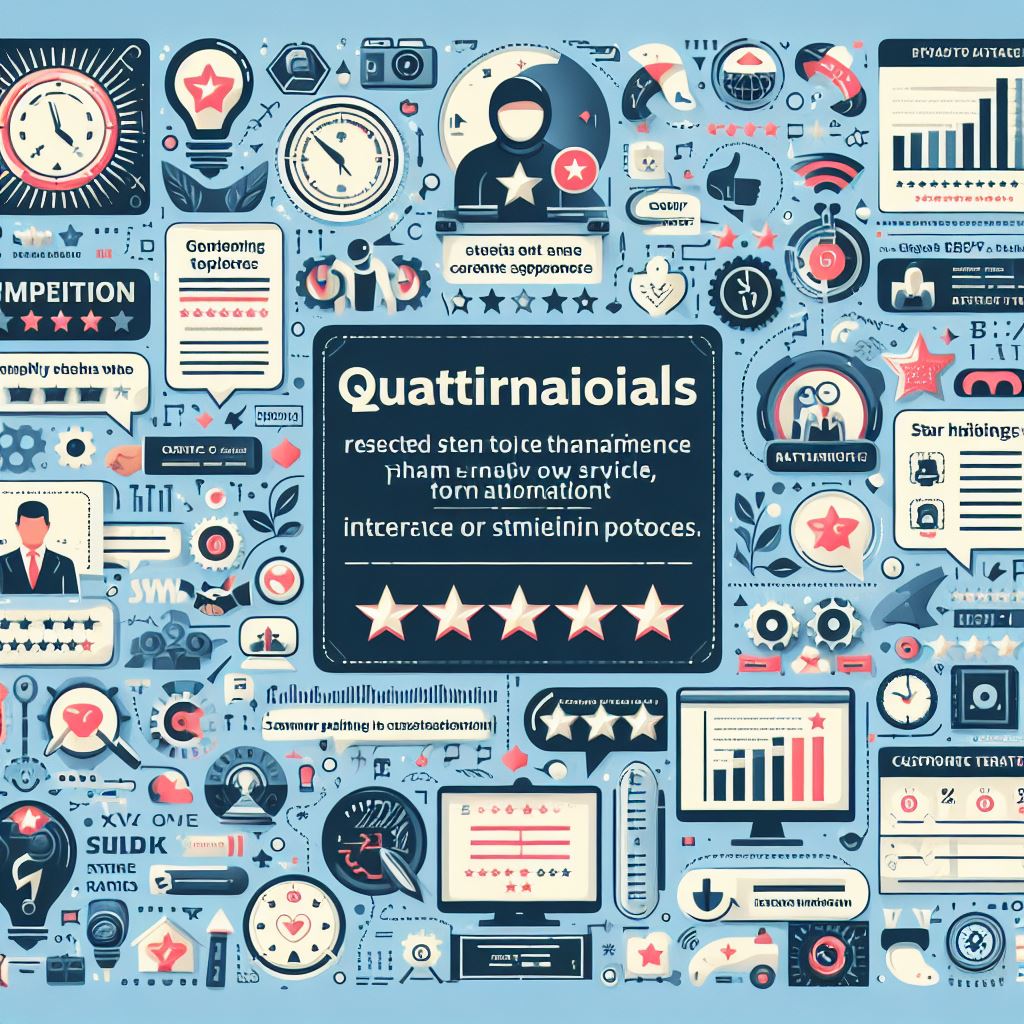When it comes to email marketing, the debate often narrows down to Flodesk vs. Mailchimp – two powerhouses that offer diverse capabilities for businesses aiming to enhance their digital communication. This comparison aims to dissect the intricacies of both platforms, offering insights into their features, usability, and overall value to help you make an informed decision. Whether you’re a seasoned marketer or a small business owner venturing into the world of email outreach, understanding the nuances of Flodesk and Mailchimp is essential for a strategy that resonates with your audience and amplifies your message.
Table of Contents
User Interface and Ease of Use
When comparing Flodesk vs Mailchimp, one of the most critical considerations for any user is the interface and how intuitive it is to navigate. The ease of use can significantly impact a marketer’s ability to create campaigns quickly and efficiently.
Starting with Flodesk, the platform takes a minimalist approach to design. Users are greeted with a clean, uncluttered interface that simplifies the process of designing emails. This can be particularly beneficial for beginners or those who prioritize a straightforward workflow without the need for extensive tutorials. The drag-and-drop editor is a standout feature, making it incredibly easy to design emails that look professional with minimal effort.
On the other side, Mailchimp has been a stalwart in the email marketing space for years, and this is reflected in its robust feature set. However, this abundance of features can make the interface seem overwhelming to new users. Despite this, Mailchimp has made significant strides in improving its user interface, offering a more streamlined experience than in the past. The platform provides comprehensive guidance and resources, which can help users navigate the complexity of its more advanced features.
Mailchimp offers more advanced options and customizations, which, while powerful, come with a steeper learning curve. Flodesk’s interface, by comparison, is more accessible from the get-go, allowing users to concentrate on creating beautiful emails rather than figuring out how to use the platform.

Template Designs and Customization
The battle of template designs and customization options is a pivotal arena in the Flodesk vs Mailchimp comparison. Email templates are the foundation of any campaign, dictating its visual appeal and engagement levels.
Flodesk shines with its modern and aesthetically pleasing templates designed to catch the eye. The platform may have fewer templates than Mailchimp, but it focuses on quality and current design trends, offering a suite of customization options that are easy to use. Flodesk users can enjoy a more streamlined customization process, with intuitive controls that make personalizing templates a breeze, even for those with little to no design experience.
Mailchimp, with its extensive history in the email marketing sector, boasts a vast library of templates catering to various industries and purposes. This wide selection means that businesses of all sizes can find something that resonates with their brand. Customization in Mailchimp is detailed, allowing for granular control over the design elements. This level of detail, however, can be double-edged; it allows for flexibility but may require more time to master.
In discussing “Flodesk vs Mailchimp,” it’s clear that both services approach template design and customization differently. Flodesk prioritizes simplicity and modern design, while Mailchimp offers breadth and depth, potentially catering to a more diverse audience.

Email Automation Features
In the debate of Flodesk vs Mailchimp, email automation features play a crucial role for businesses looking to scale their marketing efforts efficiently. Automation capabilities can dramatically improve a marketer’s ability to engage with subscribers without constant manual intervention.
Flodesk offers a simplified automation experience that’s particularly appealing to those new to email marketing or with limited technical expertise. Its workflow is straightforward, allowing users to set up sequences for welcome emails, lead nurturing, and other essential communications quickly. While Flodesk’s automation features may not be as extensive as some competitors, they cover the fundamental needs of many small businesses and solopreneurs, providing a seamless way to create attractive, automated email sequences.
Mailchimp, on the other hand, provides a more comprehensive set of automation tools. This includes advanced segmentation, behavioral targeting, and a plethora of triggers that can be customized to suit complex marketing strategies. The trade-off is that utilizing these advanced features can have a steeper learning curve, which might be intimidating for beginners.
Mailchimp stands out for businesses that need detailed, behavior-driven email campaigns, while Flodesk appeals to those seeking simplicity and ease of use.

List Management and Segmentation
When evaluating Flodesk vs Mailchimp for list management and segmentation capabilities, the focus shifts to how each platform enables users to organize and target their subscribers.
Flodesk’s approach to list management is remarkably user-friendly, with an interface that promotes ease of use. Users can easily add or remove subscribers, create segments, and manage their lists without the need for extensive technical knowledge. Segmentation in Flodesk, although simpler than Mailchimp, allows for basic targeting, which can be sufficient for small businesses or those just starting with email marketing.
Mailchimp, on the other hand, offers a more robust system for list management and segmentation. It allows for advanced segmentation based on a wide array of criteria, including subscriber behavior, purchase history, and more. This depth makes it possible to target campaigns with precision, a necessary feature for larger businesses or those with diverse customer bases.
Flodesk’s streamlined process suits those looking for simplicity, while Mailchimp’s comprehensive options cater to those who require detailed segmentation for targeted marketing efforts.

Form Building and Lead Capture
In the Flodesk vs Mailchimp comparison, the efficiency of form building and lead capture tools is essential for growing your audience and nurturing potential leads.
Flodesk offers a simplistic and intuitive form builder that’s perfect for those who prioritize design and ease of use. The platform provides aesthetically pleasing templates that can be easily customized to fit your brand’s look and feel, which makes it a breeze to create forms that convert. However, the options for customization and integration might be limited compared to more robust platforms.
Mailchimp takes form building and lead capture to a more advanced level. It boasts a wide array of form types and fields, allowing for more detailed information to be captured from potential leads. Moreover, Mailchimp’s forms can be extensively customized and integrated with a host of other services, giving users the ability to create a more seamless experience across their marketing tools.
Mailchimp is the go-to for businesses that need deep customization and integration, while Flodesk is ideal for users who want to create beautiful forms quickly and without much fuss.

Deliverability Rates
When looking at Flodesk vs Mailchimp, understanding how each platform ensures your emails actually reach the inbox is crucial. Deliverability rates can significantly impact the success of your email marketing campaigns.
Flodesk is relatively new to the scene but has quickly established a reputation for high deliverability rates. Their modern infrastructure and commitment to following best email practices contribute to consistent inbox placement. For small businesses and creatives, Flodesk’s straightforward approach to deliverability ensures that their beautifully designed emails are seen by their audience.
Mailchimp has been in the email game for much longer and has evolved its deliverability strategies over time. It offers comprehensive analytics and tools to help improve your emails’ chances of avoiding the spam folder. With Mailchimp, you get detailed reports and the ability to test and tweak various elements of your emails to optimize for the best deliverability rates.
When we consider “Flodesk vs Mailchimp” in terms of deliverability, it’s important to recognize that both platforms are strong contenders. It’s not just about the technology; it’s also about how you use it. Adhering to best practices in email marketing, such as segmenting your audience and personalizing your content, can significantly influence deliverability.

Analytics and Reporting
In the debate of Flodesk vs Mailchimp, analytics and reporting are key factors that can make or break your email marketing strategy. Both platforms offer users a way to measure the success of their campaigns, but they do so with different approaches and tools.
Flodesk offers a clean and intuitive analytics dashboard that focuses on the essentials. It provides users with clear metrics on open rates, click rates, and subscriber growth over time. This streamlined approach is perfect for those who prefer a more minimalist and less overwhelming experience.
Mailchimp, on the other hand, goes much deeper with its analytics and reporting. It offers advanced features such as click maps, subscriber activity, and ecommerce data. This extensive reporting can be incredibly beneficial for users who rely on detailed data to drive their marketing decisions. Mailchimp’s robust analytical tools allow for a granular look at campaign performance.
When comparing Flodesk vs Mailchimp for analytics and reporting, it’s important to consider your business needs. If you need detailed insights and enjoy digging into data, Mailchimp may be the way to go. For those who need straightforward analytics that are easy to digest, Flodesk could be the better option.

Integrations and Add-Ons
Choosing between Flodesk and Mailchimp often boils down to the versatility offered by integrations and add-ons. These features can expand the functionality of your email marketing software, allowing it to seamlessly work in conjunction with other tools and services that are essential for your business.
Mailchimp has a longstanding reputation for offering a wide array of integrations. Its marketplace is teeming with add-ons and integrations that cover everything from CRM systems to e-commerce platforms, enabling users to connect with a variety of third-party services such as Salesforce, Shopify, and WordPress. This makes Mailchimp a robust option for those who rely heavily on a broad ecosystem of tools.
Flodesk, while newer to the scene, has been quickly growing its integration capabilities. It focuses on offering integrations that are particularly relevant to its core user base, which includes creatives and small business owners. Flodesk’s integrations include essential services such as Zapier, which acts as a bridge to countless other applications, increasing the platform’s flexibility.
When it comes to integrations and add-ons, your specific needs will dictate which platform is more suitable. Mailchimp’s extensive library is impressive, but if you won’t make use of the plethora of options, Flodesk’s more curated selection could be a better fit, ensuring you’re not overwhelmed by choices.

Pricing Structure
When deciding between Flodesk and Mailchimp, understanding the pricing structure is critical for budget-conscious businesses and individuals. Both platforms offer different pricing models that cater to various needs and scales of operation.
Mailchimp adopts a tiered pricing structure, offering a range of plans from a basic free tier to more advanced premium options. The cost escalates with the number of contacts and the level of features required. Mailchimp’s free plan is popular among startups and small businesses, but as your contact list grows, so will your expenses. For those requiring advanced segmentation, A/B testing, and multivariate testing, premium plans are necessary.
In contrast, Flodesk offers a flat-rate pricing model. Regardless of how many subscribers you have, Flodesk charges a single monthly fee that provides access to all its features. This simplicity can be appealing, particularly for businesses that expect rapid list growth and want to avoid unexpected jumps in costs.
It’s important to note that while Flodesk’s flat rate is straightforward, it may not be cost-effective for those just starting out or with a very small list of contacts. Conversely, Mailchimp’s free tier might be more appealing in the beginning, but potentially less so as your needs expand.

Customer Support and Community
When choosing an email marketing service, customer support and community engagement can be just as crucial as the tool’s functionalities. Both Flodesk and Mailchimp understand this, offering various levels of support to their users.
Mailchimp prides itself on a comprehensive support system that includes email, live chat, and phone support, though the latter two are restricted to paid accounts. Besides direct support, Mailchimp offers an extensive knowledge base, tutorials, and marketing tips that cater to users of all experience levels. Their community forum is a vibrant space for users to share advice, marketing strategies, and troubleshoot together.
Flodesk, on the other hand, is known for its intuitive design and ease of use, which minimizes the need for frequent support. However, when assistance is needed, Flodesk provides email support and a growing selection of online resources. Flodesk’s community is fostered through social media channels, providing a place for users to connect, share designs, and offer feedback.

Compliance and Security in Email Marketing
In the world of email marketing, compliance and security are non-negotiable. Businesses must ensure their chosen email marketing platform maintains high standards for data protection and adheres to regulations such as GDPR, CAN-SPAM, and CASL.
Mailchimp has established a reputation for robust security measures and compliance adherence. It offers features like two-factor authentication and secure data storage, ensuring user and subscriber data remain protected. In addition, Mailchimp is GDPR compliant and provides users with resources to help them understand and meet their own compliance obligations.
Flodesk is newer to the market but has been built with a focus on simplicity and compliance from the ground up. Flodesk ensures that users can easily obtain consent with GDPR-compliant forms and offers transparent privacy policies that detail their security measures and data handling practices.

Pros and Cons of Flodesk vs Mailchimp
When considering an email marketing platform, understanding the pros and cons of Flodesk and Mailchimp is essential to make an informed decision. Both offer unique benefits and limitations that may influence your choice depending on your business needs.
Pros of Flodesk:
- User-Friendly Design: Flodesk’s intuitive interface allows users to create beautifully designed emails with ease.
- Flat Pricing Structure: Unlike many competitors, Flodesk offers a simple, flat-rate pricing regardless of how many subscribers you have.
- Unlimited Email Sends: Send as many emails as you want without worrying about additional costs.
Cons of Flodesk:
- Limited Integrations: As a newer platform, Flodesk currently offers fewer integrations with third-party services compared to Mailchimp.
- Basic Analytics: Its analytics are straightforward but may lack the depth that data-driven businesses require.
- Newer to Market: With a shorter track record, Flodesk doesn’t have the established reputation that some competitors hold.
Pros of Mailchimp:
- Advanced Features: Mailchimp offers a wide range of advanced features including A/B testing, automation, and complex segmentation.
- Extensive Integration Options: It integrates with a plethora of services, making it a flexible choice for many businesses.
- Comprehensive Analytics and Reporting: Mailchimp provides detailed reporting that can help optimize marketing campaigns.
Cons of Mailchimp:
- Pricing Based on Subscribers: Costs can escalate quickly as your subscriber list grows.
- Complexity: With its extensive features, new users may find Mailchimp’s platform overwhelming.
- Limited Design Flexibility: Some users find the design capabilities less intuitive and more restrictive than Flodesk’s.

Customer Reviews and Testimonials for Flodesk and Mailchimp
Making an informed decision about which email marketing service to choose can be significantly aided by examining customer reviews and testimonials for Flodesk and Mailchimp. These real-world insights provide an authentic look at the experiences of users and can highlight aspects that may not be immediately apparent through feature lists and pricing tables.
Customer Reviews for Flodesk:
- Positive Feedback often highlights Flodesk’s aesthetic email templates and user-friendly design interface, making it a favorite for those who prioritize visual appeal and simplicity in their email marketing efforts.
- Critiques tend to focus on the limited analytics and fewer integration options, which may pose a challenge for businesses looking to delve deeply into data or require extensive third-party app connectivity.
Customer Reviews for Mailchimp:
- Praise is commonly directed towards Mailchimp’s robust feature set, including its advanced analytics, extensive integration capabilities, and comprehensive automation options, which are invaluable for scaling businesses.
- Negative Reviews sometimes mention the platform’s steep learning curve and increased pricing as the subscriber list grows, which could be deterrents for new or small-scale users.
Testimonials:
- Flodesk Testimonials often come from entrepreneurs, bloggers, and small business owners who appreciate the simplicity and cost-effectiveness of the service for their email marketing campaigns.
- Mailchimp Testimonials are frequently provided by larger businesses and marketing professionals who require detailed campaign analytics and advanced segmentation features.

Final Verdict on Flodesk vs. Mailchimp
When deciding between Flodesk and Mailchimp for your email marketing needs, the final verdict hinges on your specific business requirements, aesthetic preferences, and the scale at which you operate.
Flodesk emerges as a strong contender for those who value design and ease of use above all. Its intuitive user interface and beautiful templates make it a go-to for creatives, small businesses, and those just starting with email marketing who want to create attractive emails without a steep learning curve. However, for those who need in-depth reporting and analytics, Flodesk may fall short.
Mailchimp, on the other hand, stands out for businesses that prioritize data-driven decision-making, advanced features, and scalability. With its comprehensive analytics, extensive integration options, and sophisticated automation workflows, Mailchimp caters well to growing businesses and seasoned marketers who require a high degree of customization and control over their campaigns.
Conclusion: Choosing the Right Email Marketing Tool for Your Business
Navigating the realm of email marketing tools can be a daunting task, but the importance of selecting the right platform cannot be overstated. Your email marketing software will serve as the backbone of your direct marketing efforts, influencing how effectively you can engage your audience, analyze your performance, and adapt your strategies over time.
Flodesk and Mailchimp represent two highly capable, yet distinctively different, avenues for managing your email campaigns. Flodesk’s user-friendly approach appeals to those seeking simplicity and design elegance, making it a fine choice for beginners or those with an eye for visual composition. On the other hand, Mailchimp’s robust analytics and expansive toolset offer a more granular control over marketing campaigns, a feature that can be crucial for businesses looking to scale and optimize their outreach.
Ultimately, the choice comes down to a balance between usability and functionality. For businesses making their first foray into email marketing or with limited resources to dedicate to campaign management, Flodesk’s streamlined interface may be the deciding factor. Conversely, for those who have outgrown basic email marketing functions and require detailed reporting and advanced features, Mailchimp’s comprehensive suite is likely a better fit.
Remember that the best email marketing tool is one that fits seamlessly with your business objectives and marketing strategy. It’s not just about the capabilities of the tool, but also about how well it aligns with your workflow, your team’s expertise, and your long-term growth plans.
No matter which platform you choose, the commitment to continuously learn from your analytics, to listen to your audience, and to adapt your approach will be the true determinants of your email marketing success. Keep your goals in focus, remain flexible, and always prioritize the needs and preferences of your subscribers. With the right tool and a strategic mindset, your email marketing can truly thrive.





